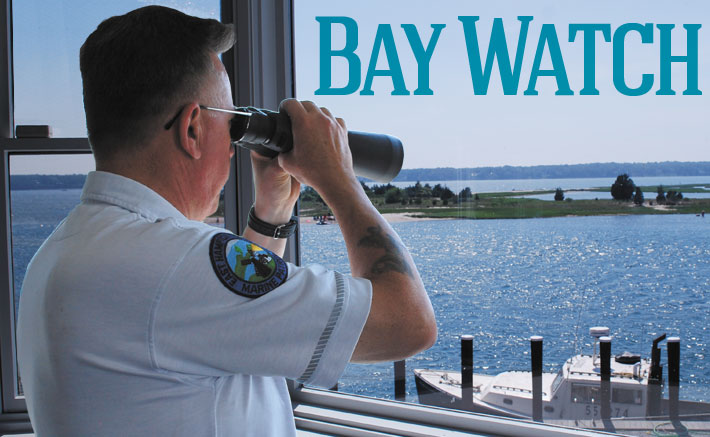

“People shouldn’t go out for a day on the water and come home in a body bag.” — East Hampton Town Bay Constable Dale Paetruska
LEAKY LIFEBOAT
Nassau Marine bureau currently has 24/7 coverage with one boat each on the north and south shores for the summer—two officers on during the day, three at night. That’s compared to 24/7 South Shore boat patrols in Suffolk, where there’s 16-hour coverage on the North Shore but about twice the full-time staff. Both departments have shrunk over the years from their heyday of 100-plus officers each.
It’s a historical trend not just relegated to county marine bureaus; bay constable agencies across the Island have seen their fair share of down-sizing over the years, too. Though officers in these marine patrol units face disparate issues across the 13 towns, an analysis of bay constable department staff, budgets and summons activity over the past five years reveals some notable comparisons.
While five LI townships were investing in the bay constables, at least three others sliced their budgets. The remainder left them as they were. And overall, the departments had an average of six boats for patrol and maintenance functions.
Last year Oyster Bay had the largest bay constable unit budget at $1.2 million, with Hempstead coming in a close second at $1 million. Including seasonal staff, Huntington had the most bay constables with 17. Riverhead Town lays claim to LI’s smallest bay constable unit with just one.
“Things are a lot more complicated out there today,” says John Valentine, head of Smithtown’s public safety department, who oversees one full timer and 12 seasonal constables to patrol one of the largest Jet Ski areas with the most small boats on LI. “At the day’s end you want everybody to have a good time. But you want to get everybody home safe. And that’s where we come in.”
Among the most drastic changes were in East Hampton’s marine department, widely considered a model, which now has three full timers—down from seven—complemented by nine seasonal part timers. Their budget is now $643,921, a 27-percent cut from their 2007 level, which coincided with a recent consolidation with the town police department and farming out tasks such as buoy maintenance.
The town, which still touts a new grant-funded patrol boat, issues up to 700 summonses annually—the most on the Island—while averaging two or three arrests, typically for BWI.
“Anybody who wants to deal with the waters, they’re going to deal with us,” says Michaels, East Hampton’s chief harbormaster.
In many LI towns, bay constables can go years without making an arrest. Brookhaven’s bay constables, for example, don’t make arrests despite having two shores to patrol. But for the rest of LI’s town marine patrols, summonses can vary from between 10 and 50 in some towns to hundreds annually.
Islip had 45 summonses or arrests in 2007, but town officials say finding annual statistics for other years was too difficult to fulfill a Freedom of Information Law request. Babylon was the only town on LI that did not release any annual statistics for their bay constables’ arrests and summonses. A town attorney says they do not keep such stats.
In their 2010 year-end report, Southampton bay constables recapped a banner year in which they broke their own record for summonses with 505. They responded to more than 1,600 calls that year, including 19 accidents, two drownings and 103 calls for assistance.
Any substantial belt-tightening scenario for Nassau’s Marine Bureau—whether currently being considered by the Mangano administration or not—would undoubtedly put more pressure on its three town bay constable units: Hempstead, North Hempstead and Oyster Bay.
“Yes, we are concerned about the cutbacks to the county,” says Colin Nash, a North Hempstead town spokesman. “That would impact how we do things if [Marine Bureau] got cut.”
Spokeswomen for the towns of Hempstead and Oyster Bay declined to comment.






